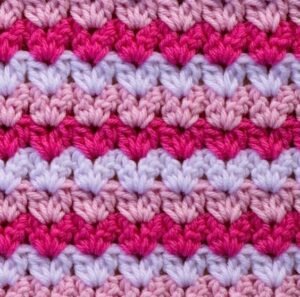Crochet is a craft that has stood the test of time, offering endless possibilities for creativity.
One of the most popular techniques within this craft is the V-Stitch Cluster, a versatile and beautiful pattern that adds texture and dimension to any project. Whether you’re creating a blanket, scarf, or shawl, the V-Stitch Cluster can elevate your work with its intricate yet easy-to-learn pattern.
In this article, we’ll walk you through the basics of crochet patterns, focusing on how to master the V-Stitch Cluster. We’ll provide a detailed step-by-step guide to help you get started, and we’ll explore some creative ways to incorporate this stitch into your projects.

What is a Crochet V-Stitch Cluster?
The V-Stitch Cluster is a variation of the traditional V-stitch, one of the most commonly used stitches in crochet patterns. It creates a “V” shape by combining chains and double crochets, forming a lattice-like pattern that’s both airy and structured. This stitch is perfect for a variety of projects, from lightweight summer garments to cozy winter blankets.
The V-Stitch Cluster adds more depth and texture than the basic V-stitch by incorporating a series of double or treble crochets into the same space. These clusters can vary in size depending on how many stitches you use, which makes it a flexible choice for any project. The crochet patterns that feature V-Stitch Clusters are often designed to be visually striking, with a rhythmic, repetitive pattern that adds charm to your work.
When you begin using the V-Stitch Cluster, you’ll notice how versatile it is. It’s ideal for beginners who want to expand their skills beyond the basic stitches, and for advanced crocheters looking to experiment with different textures. Whether you’re new to crochet or a seasoned pro, learning the V-Stitch Cluster can open up a world of possibilities.
Materials Needed for Crochet V-Stitch Cluster
Before you dive into your next crochet pattern, it’s important to gather the right materials. While the V-Stitch Cluster can be made with a variety of yarns, choosing the right type will help you achieve the best results. Here’s a breakdown of the materials you’ll need to get started:
- Yarn: The type of yarn you choose will determine the look and feel of your project. For beginners, medium-weight yarn (also known as worsted weight yarn) is a good choice. It’s easy to work with and showcases the stitches well. If you’re making a lightweight project like a shawl, opt for a thinner yarn like sport or DK weight.
- Crochet Hook: The size of the crochet hook should correspond to the yarn you’re using. For most worsted weight yarns, a 5mm or 5.5mm hook is ideal. Always check the yarn label for hook size recommendations, as this can affect the final look of your V-Stitch Cluster.
- Scissors and Tapestry Needle: A good pair of sharp scissors is essential for cutting your yarn neatly, while a tapestry needle will be used to weave in any loose ends once your project is complete.
With your materials in hand, you’re ready to begin learning the V-Stitch Cluster. Make sure to keep all these items handy as we dive into the step-by-step tutorial below.
How to Crochet a V-Stitch Cluster: Step-by-Step Guide
Mastering the V-Stitch Cluster requires patience and practice, but once you’ve got the hang of it, you’ll be able to incorporate it into a variety of crochet patterns. Below is a step-by-step guide to help you create a V-Stitch Cluster. Follow these instructions carefully, and soon you’ll have a beautiful, textured piece in no time.
Step 1: Create a Foundation Chain
Start by making a foundation chain with a multiple of 3 stitches, plus 2 additional chains for turning. For example, if you want to make a small sample, chain 15+2 (17 chains in total). The foundation chain acts as the base of your project, and the V-Stitch Cluster will be built upon it.
Step 2: Begin the First Row
To start the first row, skip the first 4 chains from the hook (these skipped chains will count as your first double crochet). In the next chain, work 1 double crochet, chain 1, and then 1 more double crochet all in the same stitch. This creates your first V-Stitch Cluster. Skip 2 chains, then repeat the pattern (1 double crochet, chain 1, 1 double crochet) across the entire row. End with 1 double crochet in the last chain of the row.
Step 3: Continue Rows with the Cluster Pattern
For the second row, chain 3 (this counts as your first double crochet) and turn your work. In the chain-1 space of the previous row’s V-stitch, work 1 double crochet, chain 1, and 1 more double crochet to form another V-Stitch Cluster. Continue this pattern across the row, placing each new V-Stitch Cluster into the chain-1 space of the previous row’s V-Stitch Cluster.
Repeat this process for as many rows as your project requires, keeping the tension even and consistent. The more rows you add, the more the lattice pattern of the V-Stitch Cluster will become visible.
Variations and Uses of the V-Stitch Cluster
The V-Stitch Cluster can be customized in a number of ways depending on your project and personal preferences. By experimenting with different crochet patterns, you can create unique designs that suit any style or purpose. Below are some of the most popular variations of this stitch:
- Double Crochet vs. Treble Crochet Clusters: The standard V-Stitch Cluster is made with double crochets, but for a more open and lacy effect, you can substitute treble crochets. This is especially useful when working on lightweight shawls or delicate scarves.
- Adding Color Changes: One of the easiest ways to make your V-Stitch Cluster stand out is by incorporating color changes. Switching colors at the end of each row can create a beautiful striped effect, adding depth and visual interest to your project.
- Using Different Yarns: The type of yarn you use can drastically change the appearance of the V-Stitch Cluster. A bulky yarn will make the stitches more pronounced, creating a bold and chunky texture. On the other hand, fine yarns will result in a dainty, intricate pattern.
By experimenting with these variations, you can personalize your projects and create something truly one-of-a-kind.
Best Crochet Patterns for V-Stitch Cluster
Once you’ve mastered the V-Stitch Cluster, you’ll want to incorporate it into a variety of crochet patterns. This versatile stitch is perfect for projects ranging from home decor to fashion accessories. Here are some of the best patterns to try:
- V-Stitch Cluster Baby Blanket: This cozy and textured blanket is perfect for a baby shower gift or to add a soft touch to any nursery. The airy structure of the V-Stitch Cluster makes it ideal for a lightweight yet warm blanket.
- V-Stitch Cluster Infinity Scarf: Stay warm and stylish with a beautiful infinity scarf that showcases the V-Stitch Cluster. The repetitive pattern is easy to follow, making it a great project for beginners looking to create something wearable.
- V-Stitch Cluster Shawl: For a more delicate and elegant project, try a lightweight shawl using a finer yarn and the V-Stitch Cluster. This pattern is perfect for spring or summer, as the open stitches allow for breathability while still providing coverage.
These patterns are a fantastic way to practice your skills and explore the endless possibilities of the V-Stitch Cluster.
Master the V-Stitch Cluster and Expand Your Crochet Repertoire
The V-Stitch Cluster is a versatile and beautiful stitch that can be used in countless crochet patterns. Its simple yet striking design makes it an excellent choice for both beginners and experienced crocheters alike. By following the step-by-step guide outlined in this article, you’ll be able to master this stitch in no time, and soon you’ll be ready to tackle more complex projects.
Whether you’re creating a cozy blanket, a stylish scarf, or an elegant shawl, the V-Stitch Cluster is sure to add a touch of texture and sophistication to your work. Keep experimenting with different yarns, colors, and stitch variations to make each project your own. Happy crocheting!

